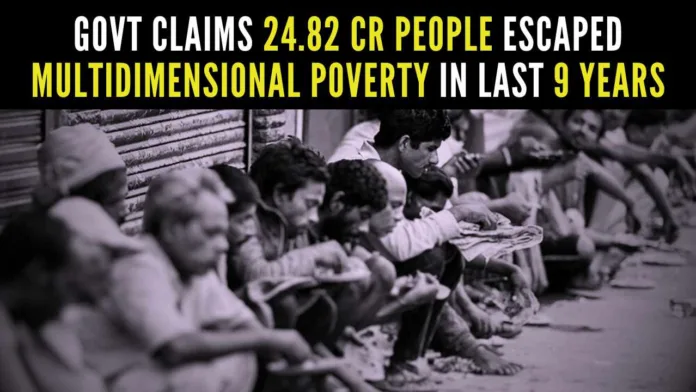
India logged a steep decline in population below the poverty line in last nine years, claims Niti Aayog
The Government of India on Monday claimed that “24.82 crore people escaped multidimensional poverty in last nine years,” citing findings of its planning and economic affairs body – Niti Aayog. Findings of NITI Aayog’s Discussion Paper ‘Multidimensional Poverty in India since 2005-06’ give credit for this remarkable achievement to significant initiatives of the government to address all dimensions of poverty between 2013-14 to 2022-23. The discussion paper was released today by Prof Ramesh Chand, Member, NITI Aayog in the presence of Shri B V R Subrahmanyam, CEO of NITI Aayog. Oxford Policy and Human Development Initiative (OPHI) and the United Nations Development Programme (UNDP) have provided technical inputs for this paper, said the Modi government.
The Multidimensional Poverty Index (MPI) is a globally recognized comprehensive measure that captures poverty in multiple dimensions beyond monetary aspects. MPI’s global methodology is based on the robust Alkire and Foster (AF) method that identifies people as poor based on a universally acknowledged metric designed to assess acute poverty, providing a complementary perspective to conventional monetary poverty measures.
According to the Discussion Paper, India has registered a significant decline in multidimensional poverty in India from 29.17% in 2013-14 to 11.28% in 2022-23 i.e. a reduction of 17.89 percentage points. Uttar Pradesh registered the largest decline in the number of poor with 5.94 crore people escaping multidimensional poverty during the last nine years followed by Bihar at 3.77 crore, Madhya Pradesh at 2.30 crore, and Rajasthan at 1.87 crore.
The paper also shows that the pace of decline in poverty headcount ratio using the exponential method was much faster between 2015-16 to 2019-21 (10.66% annual rate of decline) compared to the period 2005-06 to 2015-16 (7.69% annual rate of decline). All 12 indicators of MPI have recorded significant improvement during the entire study period. To assess the poverty levels in the year 2013-14 against the current scenario (i.e. for the year 2022-23), projected estimates have been used due to data limitations for these specific periods.
“Significant initiatives covering all dimensions of poverty have led to 24.82 crore individuals escaping multidimensional poverty in the last 9 years. As a result, India is likely to achieve its SDG target of halving multidimensional poverty well before 2030. The government’s persistent dedication and resolute commitment to enhancing the lives of the most vulnerable and deprived have been instrumental in this accomplishment.
“The Government of India has made remarkable progress in improving the lives of people, aiming to reduce poverty in all dimensions. Noteworthy initiatives like Poshan Abhiyan and Anemia Mukt Bharat have significantly enhanced access to healthcare facilities, leading to a substantial decrease in deprivation. Operating one of the world’s largest food security programs, the Targeted Public Distribution System under the National Food Security Act covers 81.35 crore beneficiaries, providing food grains to rural and urban populations. Recent decisions, such as extending free food grain distribution under Pradhan Mantri Garib Kalyan Anna Yojana for another five years, exemplify the government’s commitment. Various programs addressing maternal health, clean cooking fuel distribution through Ujjwala Yojana, improved electricity coverage via Saubhagya, and transformative campaigns like Swachh Bharat Mission and Jal Jeevan Mission have collectively elevated living conditions and overall well-being of people. Additionally, flagship programs like Pradhan Mantri Jan Dhan Yojana and PM Awas Yojana have played pivotal roles in financial inclusion and providing safe housing for the underprivileged,” claimed the Modi government, ruling India from mid-2014, going to face General Election in April – May 2024.
For all the latest updates, download PGurus App.
- Supreme Court rejects plea to tally all VVPAT slips with EVM votes; says ‘no going back to paper ballot’ - April 26, 2024
- US report citing human rights violations is deeply biased: India - April 25, 2024
- Kotak Mahindra Bank shares tank 13%. Market Cap erodes by Rs.37,721 cr post-RBI action - April 25, 2024










